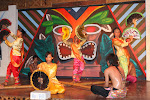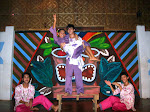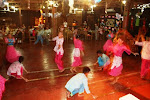The Philippines consist of 7107 islands, and is broken down in three groups of islands. The Luzon, Mindano, and Visayas. Each of these regions contain different languages,history, regligon, and traditions. With each region having different influence in thier arts, crafts, and ancestorical dances. Lets take a trip through each region and explore the different styles, costumes, Dances and Talents from Each Region.... As we explore each of the regions and styles, please remember alot of these Cultural and Folk dances represents hardships and daily back breaking tasks, that has turned into a art form. Many of the dances you will read about here were actuall activities or chores that the Filipino endured to survive the poor economy and state of the nation.....
 Traditions and Hertitage - Luzon Region
Traditions and Hertitage - Luzon Region
LUZON -- Consisting of the tribes such as Ifugao, Benquet, Kalinga, Bontoc, Apayo, Kalinga, sometimes these are call Igorot. " But sometimes that is considered degrading ." Cordillerea name also used for some parts the Luzon Region...
Northern most region of the Philippines, Luzon gets its Cultural influence from Hindu-Buddist, Spanish and many ethnic regilous tribes. All with differences and beliefs. But in all the Cultural and Folk Dances from this region represents all different factions in one way or the other.
Dances of Luzon ( see side bar for pictures of many of the dances )
* Dance: Idaw
This dance sometimes has many names and different versions. Most common is this dance depicts the hunting ritual performed before a tribal war. The tribes men would go out and look up and watch for the scared Idaw bird. Which is said to lead the tribe to victory. Also look at the clothing, Philippines being a very hot climate, plus the use of as little material as possible, the traditional clothing was not made to cover much of the body....
* Dance : Banga
This dance displays the Igorot women on their way to the river to fetch the daily water supply for thier familys. It shows the skill and strength of the women as they would carry heavy laiden clay pots (Banga) full of water. Their grace and agility while balancing the heavy pots, sometimes stacks 5 high, is a testiment of the Filipino and how hardships become a art form and talent. As a young girl you would start with only one pot. Of course as you become older and more experienced, along with the fact that you could provide more water for your family in one trip. Pots could be stacked as high as 5 or 6. The more pots you could carry showed your skill and also you standing amoung the women of that area. They would all gather and march to the river each day, singing a native song which is represented by the flute and banging of bamboo on iron pots in the dance......
* Dance : Idudu
The family is the basic structure of family life among the Itneg / Tinggian poeple. The caring for the Children is shared by both the mother and father. While the men are clearing the fields, breaking the soil with bamboo and their feet, the women watch the children. Soon as the men are done, they take care of the children while the women do back breaking work. You can see in the dance how the women will take the bamboo baskets in a shaking fashion like drying the rice, while the men are going in circles in background like they are toiling the land. Then you will see the women put down the baskets fold the cloth into a baby while the husband stands aside. Then the women will turn over the baby to the husband, pick up the bamboo and start toiling the land while the men hold and cradle the babys.........
* Dance : Ragsaksakan
The word means " Merriment". This dance would be performed after a successful headhunt and also for a peace pact between waring tribles. The colorful hand woven blankets " blankets of life" are worn around the neck while baskets to carry produce or rice are worn upon the head. Some versions of this dance use the " Banga " instead of the basket.
Pride and Honor - Mindanao Region
 Filipino is Worth Dieing For
Filipino is Worth Dieing For Dances of Mindanao - ( See side bar for pictures and more info)
Sinkil dance takes its name from the bells worn on the ankles of the Muslim princess. Perhaps one of the oldest of truly Filipino dances, the Singkil recounts the epic legend of the "Darangan" of the Maranao people of Mindanao. This epic, written sometime in the 14th century, tells the fateful story of Princess Gandingan, who was caught in the middle of a forest during an earthquake caused by the diwatas, or fairies or nymph of the forest.
The rhythmic clapping of criss-crossed bamboo poles represent the trees that were falling, which she gracefully avoids. Her slave loyally accompanies her throughout her ordeal. Finally, she is saved by the prince. Dancers wearing solemn faces and maintaining a dignified pose being dancing at a slow pace which soon progresses to a faster tempo skillfully manipulate apir, or fans which represent the winds that prove to be auspicious. The dancers weave expertly through criss-crossed bamboos.
* Dance : Kini Kini
Kini means the Royal Walk. Maranao women performed this dance with scarves. The beauty of the scarve and the talent and grace in which it is displayed. Shows their elite social upbringing.
A pangalay native to the Badjao, sometimes known as the "Sea Gypsies." Pangalay is a dance that emphasizes the agility of the upper body. The rhythmic bounce of the shoulder with simultaneous alternating waving of arms are the basic movement of this dance. The pangalay is commonly performed at weddings and other social gatherings. You will also see some parts of the Sinkgil in this dance also. Another part of this dance is also called the Muslium four Bamboos.
* Dance : Asik
This is performed by a solo madien, adorned with fine beads and make up, long head scarf. She would dance to win the favor of her Sultan master. Many time the girls would dance to win the hearts of her master or to make up for a wrong she had done. She would give her whole heart and soul into this performance to soften the heart of her master to accept her...
LOVE OF LIFE AND COUNTRY - VISAYAS REGION

VISAYAS -- Being the Central Island of The Philippines, Visayas is also broken down into three sections. Central , Eastern, Western. Consisting of Austronesians, Negritos, these we Animist Tribal Group. Many others tribes from around surrounding island would come after the downfall or break up of thier tribes. Visayas became a melting pot for many different Tribes and Cultural backgrouds. You will find Arbian, Spanish, and some Western influences in the dances of this region. You will see that the dances of the Visayas are more upbeat and exciting, not so much in Drama and tribal meanings as other regions.
Visayas Dances - ( see pictures in the side bar )
* Dance : Sayaw Sa Banko
This dance is native to the barrio of Pangapisan, Lingayen, Pangasinan, and demands skill from its performers who must dance on top of a bench roughly six inches wide.
* Dance : Tinkling
Tinnikling is considered the national folkdance with a pair of dancers hopping between two bamboo poles held just above the ground and struck together in time to music. Originated from Leyte Province, this dance is in fact a mimic movement of “tikling birds” hopping over trees, grass stems or over bamboo traps set by farmers. Dancers perform this dance with remarkable grace and speed jumping between bamboo poles.
* Dance : Subli
The term “subli” is from two tagalog words “subsub” meaning falling on head and “bali”, which means broken. Hence, the dancers appear to be lame and crooked throughout the dance. This version is originally a ritual dance of the natives of Bauan, Batangas, which is shown during fiestas as a ceremonial worship dance to the town’s icon, the holy cross
* Dance : Maglalatik
Originally performed in Binan, Laguna as a mock-war dance that demonstrates a fight between the Moros and the Christians over the prized latik or coconut meat during the Spanish rule, this dance is also shown to pay tribute to the town’s patron saint, San Isidro Labrador. It has a four-part performance such as the palipasan and the baligtaran showing the intense battle, the paseo and the escaramusa- the reconciliation. Moro dancers wear read trousers while the Christian dancers show up in blue. All dancers are male; with harnesses of coconut shells attached on their chests, backs, thighs and hips
















5 comments:
Great Blog, never got so precise information's about the dances in that short way
tx for that
Hello
My name is Kate Frenson and I recently found your website about dances of Philippine. You show an interesting site of the country. Philippines are a beautiful place, with rich history and interesting culture. I didn't know that there is so much potential in folk dances. This is really interesting. I like especially Kini Kini, feels so elegant and noble. I think that more people should get a chance to learn more about Philippines. That is why I wanted to give your website a feedback. I thought that you could be interested in adding more basic info about culture of Philippines. This could be beneficial and make your website more visible among internet, even more popular. It could also attract more people to come and see Philippines in flesh. Maybe you could be interested in adding a link to www.everyculture.com/No-Sa/Philippines.html ?. Please let me know what do you think about that.
Thank you,
Kate Frenson
Awesome! Very nice details on Philippine Folk Dances. Thanks!
nice blog... very informative..
http://philippinesbeachesandresorts.blogspot.com
follow us
Thank you! Great info.
Post a Comment